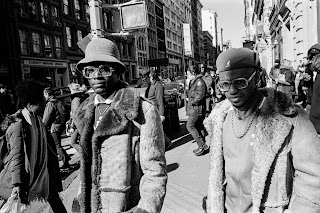people watching and street photography II.
First sold in 1925, the Leica was the first commercially successful camera to use 35 mm film. Its compactness and bright viewfinder matched to lenses of quality helped photographers move through busy streets and capture fleeting moments.
Henri Cartier-Bresson acquired the Leica camera
with 50 mm lens in Marseilles that would accompany him for many years. The
anonymity that the small camera gave him in a crowd or during an intimate
moment was essential in overcoming unnatural behavior of those who were aware
of being photographed. (He enhanced his anonymity by painting all shiny parts
of the Leica with black paint.) The Leica opened up the ability to capture the
world in its actual state of movement and transformation.
Henri Cartier-Bresson:
I went to Marseille. A small allowance enabled me to
get along, and I worked with enjoyment. I had just discovered the Leica. It
became the extension of my eye, and I have never been separated from it since I
found it. I prowled the streets all day, feeling very strung-up and ready to
pounce, determined to "trap" life--to preserve life in the act of
living. Above all, I craved to seize the whole essence, in the confines of one
single photograph, of some situation that was in the process of unrolling
itself before my eyes.
Walter Benjamin in The Arcades Project: "the
flâneur" is an invention of the French poet Charles Baudelaire who is depicted
as a passionate wanderer. The flâneur was a figure of the modern artist-poet, a
figure keenly aware of the bustle of modern life, an amateur detective and
investigator of the city, but also a sign of the alienation of the city and of
capitalism.
"The arcades dot the metropolitan landscape
like caves containing the fossil remains of a vanished monster: the consumer of
the pre-imperial era of capitalism, the last dinosaur of Europe."


Comments
Post a Comment